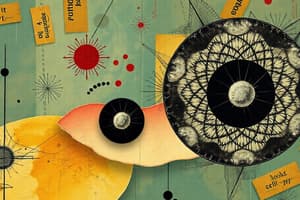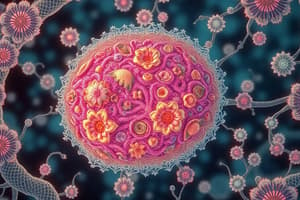Podcast
Questions and Answers
Which component of the cell serves as the site of protein synthesis?
Which component of the cell serves as the site of protein synthesis?
- Mitochondria
- Golgi Apparatus
- Ribosomes (correct)
- Endoplasmic Reticulum
Which type of cell lacks a nucleus?
Which type of cell lacks a nucleus?
- Animal cells
- Eukaryotic cells
- Prokaryotic cells (correct)
- Plant cells
In which cellular structure does photosynthesis occur?
In which cellular structure does photosynthesis occur?
- Nucleus
- Lysosomes
- Chloroplasts (correct)
- Rough Endoplasmic Reticulum
What is the primary function of the Smooth Endoplasmic Reticulum?
What is the primary function of the Smooth Endoplasmic Reticulum?
Which process results in the production of gametes?
Which process results in the production of gametes?
What describes passive transport across the cell membrane?
What describes passive transport across the cell membrane?
What is the primary purpose of the Golgi apparatus?
What is the primary purpose of the Golgi apparatus?
Which of the following statements is NOT part of the cell theory?
Which of the following statements is NOT part of the cell theory?
Flashcards are hidden until you start studying
Study Notes
Cell Biology
-
Cell Theory
- All living organisms are composed of cells.
- The cell is the basic unit of life.
- All cells arise from pre-existing cells.
-
Types of Cells
- Prokaryotic Cells
- Lack a nucleus and membrane-bound organelles.
- Examples: Bacteria and Archaea.
- Eukaryotic Cells
- Have a nucleus and membrane-bound organelles.
- Examples: Plant cells, animal cells, fungi, and protists.
- Prokaryotic Cells
-
Cell Structure
- Plasma Membrane
- Semi-permeable barrier that controls movement in and out of the cell.
- Nucleus
- Contains genetic material (DNA) and controls cellular activities.
- Cytoplasm
- Gel-like substance where cell components are suspended.
- Organelles
- Mitochondria: Powerhouse of the cell, produces ATP through respiration.
- Ribosomes: Sites of protein synthesis.
- Endoplasmic Reticulum (ER):
- Rough ER: Studded with ribosomes, synthesizes proteins.
- Smooth ER: Lacks ribosomes, involved in lipid synthesis.
- Golgi Apparatus: Modifies, sorts, and packages proteins and lipids.
- Lysosomes: Contain enzymes for digestion of waste materials.
- Chloroplasts (in plant cells): Site of photosynthesis.
- Plasma Membrane
-
Cell Division
- Mitosis
- Process of cell division resulting in two identical daughter cells.
- Stages: Prophase, Metaphase, Anaphase, Telophase.
- Meiosis
- Specialized form of cell division that produces gametes.
- Results in four non-identical daughter cells with half the chromosome number.
- Mitosis
-
Cell Function
- Metabolism
- All biochemical processes occurring within cells, including catabolism and anabolism.
- Cell Signaling
- Mechanisms through which cells communicate with each other.
- Involves ligands, receptors, and signal transduction pathways.
- Metabolism
-
Cellular Transport
- Passive Transport
- Movement of substances across cell membranes without energy (e.g., diffusion, osmosis).
- Active Transport
- Movement of substances against a concentration gradient, requiring energy (e.g., sodium-potassium pump).
- Passive Transport
-
Cell Communication
- Direct Communication
- Gap junctions allow direct transfer of ions and small molecules between cells.
- Chemical Signaling
- Involves hormones and neurotransmitters acting on target cells.
- Direct Communication
-
Stem Cells
- Undifferentiated cells with the potential to develop into different cell types.
- Types: Embryonic stem cells and adult (somatic) stem cells.
-
Cell Cycle Regulation
- Controlled by checkpoints (G1, S, G2, M phases) to ensure proper division.
- Abnormal regulation can lead to cancer.
Cell Theory
- All living organisms are made up of cells.
- The cell is considered the basic unit of life.
- Cells originate from pre-existing cells.
Types of Cells
- Prokaryotic Cells
- Do not have a nucleus or membrane-bound organelles.
- Examples include Bacteria and Archaea.
- Eukaryotic Cells
- Contain a nucleus and various membrane-bound organelles.
- Examples include plant cells, animal cells, fungi, and protists.
Cell Structure
- Plasma Membrane
- Functions as a semi-permeable barrier regulating movement in and out of the cell.
- Nucleus
- Houses genetic material (DNA) and governs cellular functions.
- Cytoplasm
- Gel-like matrix that suspends cell components.
- Organelles
- Mitochondria: Known as the powerhouse, it generates ATP through respiration.
- Ribosomes: Responsible for protein synthesis.
- Endoplasmic Reticulum (ER):
- Rough ER synthesizes proteins due to the presence of ribosomes.
- Smooth ER is involved in lipid synthesis and lacks ribosomes.
- Golgi Apparatus: Modifies, sorts, and packages proteins and lipids for distribution.
- Lysosomes: Contain digestive enzymes for breaking down waste.
- Chloroplasts: Found in plant cells, these are the sites for photosynthesis.
Cell Division
- Mitosis
- A process that results in two genetically identical daughter cells.
- Involves distinct stages: Prophase, Metaphase, Anaphase, and Telophase.
- Meiosis
- A specialized division that produces gametes (sex cells).
- Results in four non-identical daughter cells, each with half the number of chromosomes.
Cell Function
- Metabolism
- Encompasses all biochemical processes in cells, including catabolism (breaking down molecules) and anabolism (constructing molecules).
- Cell Signaling
- Refers to how cells communicate through mechanisms including ligands and receptors.
- Involves signal transduction pathways for effective communication.
Cellular Transport
- Passive Transport
- Movement of substances across membranes without energy input (examples: diffusion and osmosis).
- Active Transport
- Requires energy to move substances against their concentration gradient (e.g., sodium-potassium pump).
Cell Communication
- Direct Communication
- Gap junctions allow for the direct transfer of ions and small molecules between adjacent cells.
- Chemical Signaling
- Involves the action of hormones and neurotransmitters on target cells.
Stem Cells
- Undifferentiated cells capable of developing into various cell types.
- Types include embryonic stem cells and adult (somatic) stem cells.
Cell Cycle Regulation
- Checkpoints at G1, S, G2, and M phases ensure accurate division and function.
- Abnormal regulation can lead to the development of cancer.
Studying That Suits You
Use AI to generate personalized quizzes and flashcards to suit your learning preferences.




